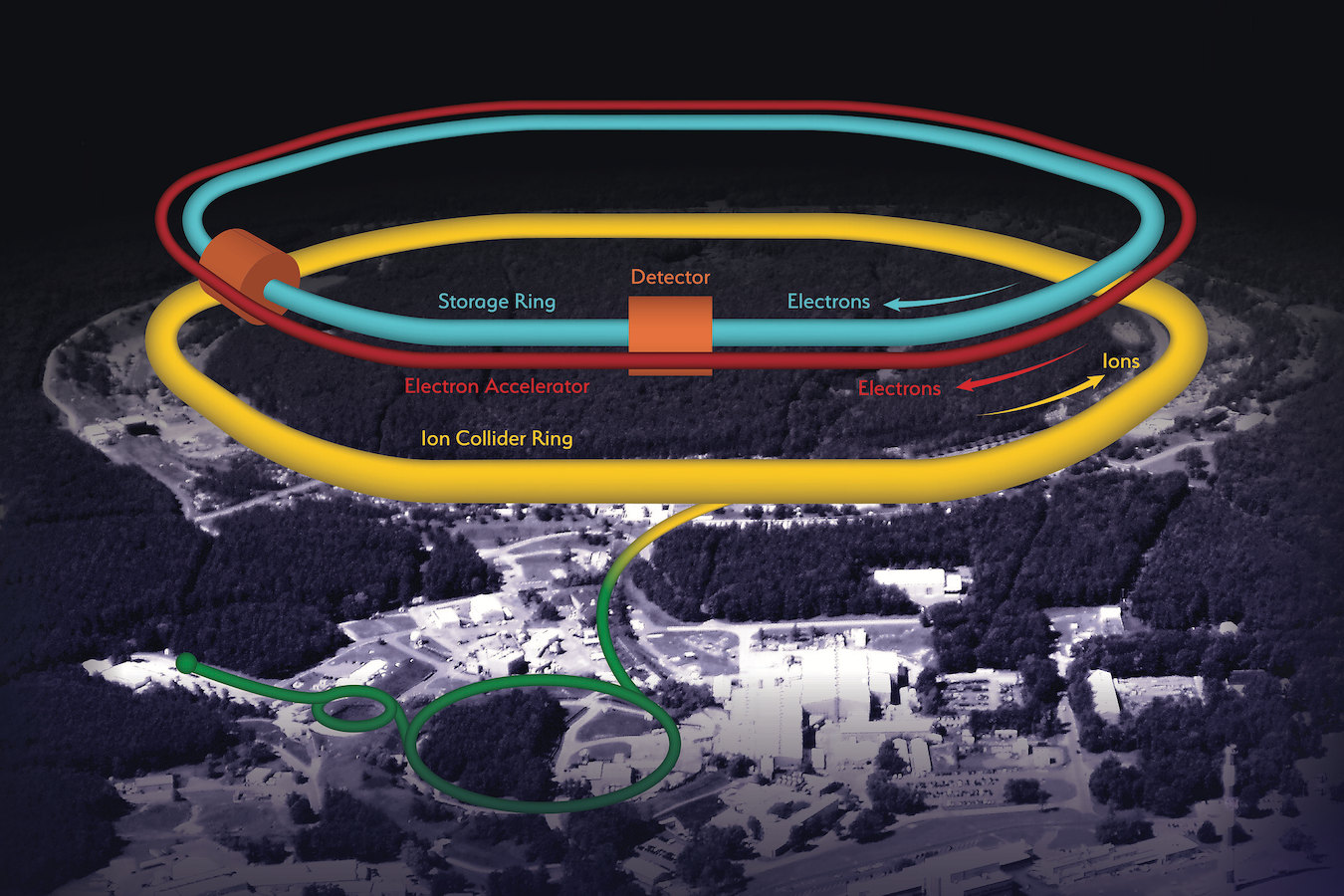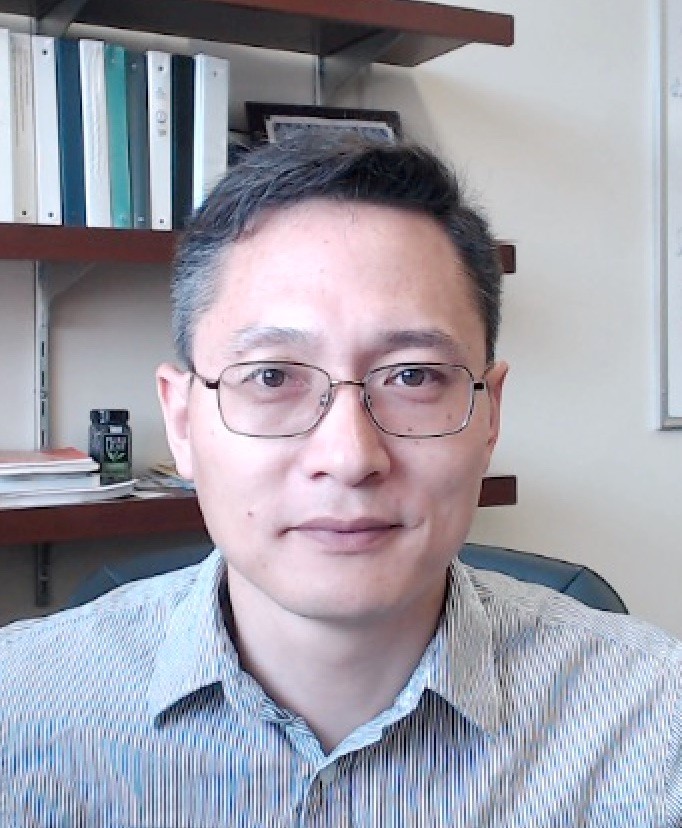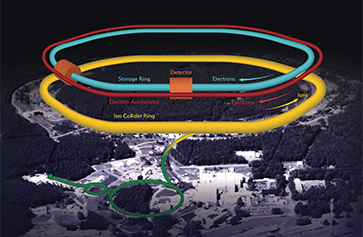UCLA, partners win Department of Energy grant to boost diversity in field of nuclear physics

Trainees will have the unique opportunity to conduct research related to the DOE’s new Electron-Ion Collider in New York (pictured), where scientists hope to determine the structure of quarks and gluons, the building blocks of matter. Image credit: Brookhaven National Laboratory/DOE
By Stuart Wolpert
The UCLA Department of Physics and Astronomy has received federal government funding for a pilot program designed to help low-income, first-generation and historically underrepresented undergraduate students from across California pursue graduate degrees and careers in nuclear physics, with the aim of increasing the diversity of scientists in this field.
The $500,000 grant from the nuclear physics program in the U.S. Department of Energy’s Office of Science will support training, mentorship and hands-on research experiences for students, including internships at national laboratories and the opportunity to work on research related to the DOE’s cutting-edge Electron-Ion Collider, said associate professor of physics Zhongbo Kang, who is heading the program at UCLA.
The grant-funded program is a collaboration among UCLA, UC Riverside, the Lawrence Berkeley and Lawrence Livermore national laboratories, Cal Poly Pomona and the Cal-Bridge program, a statewide network of nine UC, 23 CSU and more than 110 community college campuses that seeks to create greater opportunities for underrepresented minorities in STEM fields. The undergraduate trainees are selected through Cal-Bridge.

Associate professor of physics Zhongbo Kang, who is heading the grant-funded program at UCLA and coordinating trainees’ work on the Electron-Ion Collider. Image Courtesy of Zhongbo Kang
“The UC and CSU systems are among the largest engines for social mobility in the United States and play a key role in providing opportunities to students from disadvantaged backgrounds,” said Kang, who is a member of both the Mani L. Bhaumik Institute for Theoretical Physics and the Center for Quantum Science and Engineering at UCLA. “Their student bodies contain the largest pool of low-income, first-generation and underrepresented minority students in the nation, and we are in an excellent position to tap into this pool and broaden the nuclear physics pipeline.”
During each year of the two-year program, four trainees will join research groups at UCLA or UC Riverside and will intern for 10 weeks during the summer at either Lawrence Berkeley National Laboratory or Lawrence Livermore National Laboratory. At UCLA, the nuclear physics group conducts theoretical research under Kang’s leadership and experimental research under professor of physics Huan Huang. Trainees will be integrated into one of these groups based on their research interests and will work with the professors and a team of undergraduates, graduate students, postdoctoral scholars and staff scientists.
DOE’s Electron-Ion Collider: The future of nuclear physics
The chance to conduct research related to the nascent Electron-Ion Collider, or EIC — the DOE’s flagship research project for the future of nuclear physics — is a one-of-a-kind opportunity for the trainees, Kang said, and he hopes the experience will help them see themselves as members of the EIC community. The massive facility, to be built on Long Island, New York, will use electron collisions with protons and atomic nuclei to produce images of quarks and gluons — the elementary building blocks of matter. In California, scientists will be working on the physics undergirding the collider and developing the facility’s detectors. The next few years will be a critical period for the design of the detectors.
“Given that the EIC experiments will likely start in about 10 years and run until mid-century, the students will see that they could become deeply ingrained with the project,” said Kang, who will coordinate the EIC research training programs with the California EIC consortium. “Our goal is to establish a Ph.D. bridge to the EIC program by training a cohort of students from diverse backgrounds that will be in an excellent potion to apply to graduate school. The EIC project provides an excellent platform for training the next generation of scientists.”
The undergraduate trainees will present their research results at conferences and participate in the meetings and workshops of the American Physical Society’s Division of Nuclear Physics and the California EIC consortium. They will learn to work effectively on large research projects, communicate results to other scientists and general audiences, learn software skills to run large-scale physics simulations and develop technical expertise in data science and machine learning.
The first trainees began the program this month. The $500,000 grant is part a larger, $3 million DOE effort to broaden and diversify nuclear and particle physics through research traineeships for undergraduates.
“The ability to fulfill our mission to discover, explore and understand all forms of nuclear matter relies on the availability of a highly trained, diverse community of investigators, researchers, students and staff,” said Timothy Hallman, the DOE’s associate director of science for nuclear physics. “The goal of this program is to help broaden and diversity this community to ensure that it is drawn from the broadest possible pool of potential nuclear and particle physicists within the U.S.”
This article originally appeared in the UCLA Newsroom. For more news and updates from the UCLA College, visit college.ucla.edu.


 Brookhaven National Laboratory/DOE
Brookhaven National Laboratory/DOE Courtesy of Yogita Goyal
Courtesy of Yogita Goyal John MacColgan/Creative Commons
John MacColgan/Creative Commons